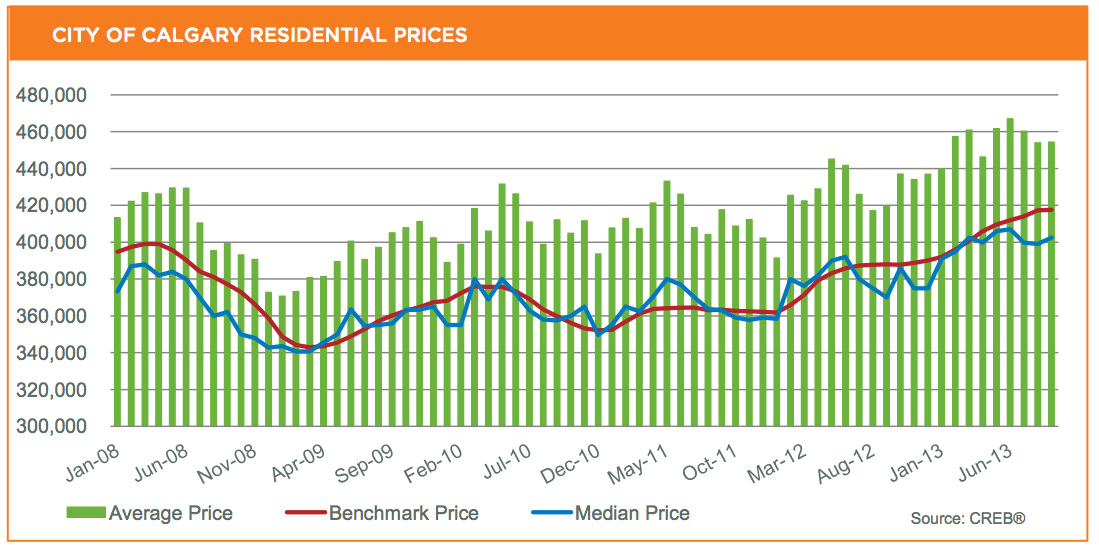Remax Ontario and Atlantic Canada
Kid-Proof Your Design
All types of flooring are subject to possible damage; try to consider your new hardwood scratches as a natural and charming authentic aging process. Tile can break, carpet can stain and Marmoleum can get damaged. Whether it’s you moving the fridge for cleaning or the kids riding their skateboards in the house while you are out in the backyard, make sure you choose the best quality you can afford and don’t worry about life’s little accidents.
When you are furnishing the living room, consider investing in pieces that will last. You can always re-cover the chairs or sofa once the little ones are grown. This is a far better option than purchasing disposable furniture that will end up in a landfill when you are ready to buy your “real” furniture.

by Lori.Andrews on Sep 16, 2013
– See more at: http://www.crebnow.com/kid-proof-your-design/#sthash.O8lhY3gD.dpuf
CALGARY REGIONAL HOUSING MARKET STATISTICS for August 2013
SUMMER SALES STAY STRONG
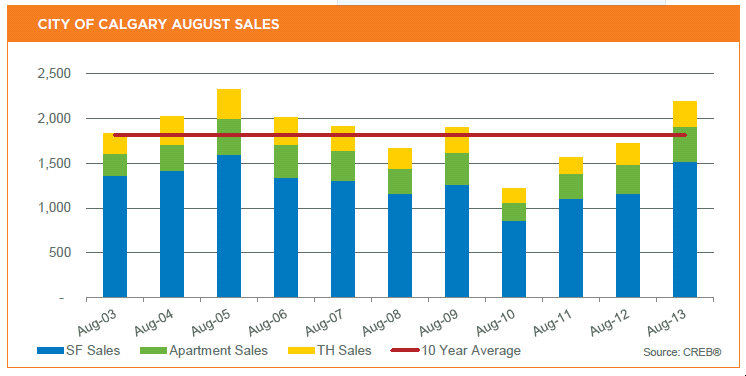
Seller’s market conditions persist, pushing up prices
(click on the photo above to download the full report)
Residential sales within city limits totaled 2,196 units, an 27.5 per cent increase over 2012 and 8.7 per cent on a year-to-date basis.
The level of transactions was well above long-term trends for the month, mostly due to improved activity in the single-family sector. However, on a year-to-date basis, activity is only slightly higher than expectations.
“The sales have been limited by the need for more resale listings,” said CREB® President Becky Walters. “However, August did see more new listings than last year, giving buyers more choice.”
August new listings recorded a year-over-year improvement of 7.4 per cent. While seller’s market conditions persist and total inventory levels keep falling, improvement in new listings helped prevent further tightening in the market despite the sales growth.
Single-family sales totaled 1,517 units in August, a 30 per cent increase over the previous year. Despite strong sales in the past couple of months, year-to-date sales activity has grown by 5.4 per cent, slightly stronger than anticipated.
Click on the following link to download the full report of the Monthly Housing Statistics for August.
Calgary to lead cities in real GDP growth
In a report released Wednesday, the bank said June flooding in southern Alberta will contribute to a slowdown in Calgary’s GDP growth in the first half of 2013, with losses likely recouped in the second half of the year and into 2014.
The report said Calgary should be the only census metropolitan area in Canada to record economic growth of more than 4 per cent next year.
“While the June floods derailed things a bit, Calgary’s fundamentals are good,” said Ben Brunnen, a Calgary economic consultant. “Low unemployment, tight commercial vacancy rates and strong population growth will keep the economy humming into 2014.”
The city’s biggest challenges in 2014 will likely be growth-related, Brunnen said.
“Rising mortgage rates and low vacancy rates will reduce housing affordability, while strong interprovincial migration could strain our municipal infrastructure and services,” he said.
“Labour shortages in the construction trades is another area to watch, as flood rebuilding efforts and strong commercial construction activity could lead to higher costs and potentially reduce the quality of the work.”
The TD report is forecasting economic growth of 2.5 per cent for the country in 2014.
For this year, TD Economics said St. John’s will lead the country with 4.0 per cent growth followed by Calgary at 3.2 per cent. Nationwide, economic growth for 2013 is expected to be 1.8 per cent.
“Stronger energy prices and a continued steady inflow of job seekers into the province will lift construction spending and retail sales,” said Todd Hirsch, chief economist at ATB Financial. “The only danger remains the job market overheating somewhat, driving wage costs for employers higher.”
Mario Toneguzzi, Calgary Herald
Published: Thursday, September 05, 2013
City's housing affordability 'among better in Canada'
Calgary’s housing market appears to have weathered the worst floods in memory with the second-strongest quarterly sales gain in four years, says the Royal Bank.
“A strong provincial economy, solid labour market, fast-rising population, and attractive affordability continue to fuel demand for Calgary housing,” said the bank’s latest Housing Trends and Affordability Report, to be released Tuesday.
The RBC report, which measured the April to June period, said monthly resale activity increased for six straight months, including in June (rising 1.1 per cent month-overmonth) and July (up 3.1 per cent). On a quarterly basis, home resales rose 12 per cent.
“While prices recently embarked on a more steeply upward trajectory, the effect of faster-rising prices has yet to undermine affordability in any material way,” said RBC. “In fact, affordability levels in Calgary continue to be among the better in Canada.”
The RBC affordability index determines the proportion of median pretax household income needed to service the cost of mortgage payments, property taxes and utilities.
Its measures for Calgary showed little movement in the second quarter, with two-storey homes rising by 0.5 percentage points to 33.6 per cent, while condominium apartments edged lower by 0.2 percentage points to 19.4 per cent.
And while the report cautions home ownership has become less affordable for the average Canadian, RBC said Alberta homebuyers continued to enjoy a relatively affordable housing market.
“Despite the fact that the market has kicked into higher gear since spring – thereby boosting prices and increasing ownership costs – Alberta continues to be a relatively affordable market,” said Craig Wright, senior vice-president and chief economist with RBC. “We will likely see some disruptions in market activity trickle through in summer data from the floods in southern Alberta; however, we anticipate the strong provincial economy will endure, supporting further housing growth in 2014.”
Nationally, during the second quarter, affordability measures rose for two of the three categories of homes tracked. RBC’s measure for the detached bungalow rose 0.3 percentage points and for the standard two-storey home rose 0.4 percentage points to 42.7 per cent and 48.4 per cent, respectively. The measure for the standard condominium was unchanged at 27.9 per cent.
Vancouver’s affordability measure gained 2.2 points to 82.1 on a detached bungalow, while Toronto’s increased half a point to 54.5.
Calgary housing market forges on despite June flooding…
Affordability levels in Calgary are among best in Canada
Not even the worst floods in memory in June appear to have slowed the Calgary housing market’s progression this year, says a report by RBC Economics Research.
“A strong provincial economy, solid labor market, fast-rising population and attractive affordability continue to fuel demand for Calgary housing,” said the bank’s latest Housing Trends and Affordability Report.
It said monthly resale activity increased for six straight months, including in June (rising 1.1 per cent month-over-month) and July (up 3.1 per cent). On a quarterly basis, home resales in the area posted their second-strongest gain (12 per cent) in four years in the second quarter.
“While prices recently embarked on a more steeply upward trajectory, the effect of faster-rising prices has yet to undermine affordability in any material way,” said RBC. “In fact, affordability levels in Calgary continue to be among the better in Canada.”
RBC measures for Calgary showed little movement across all housing categories in the second quarter of 2013. RBC’s measure for two-storey homes rose by 0.5 percentage points to 33.6 per cent and for condominium apartments edged lower by 0.2 percentage points to 19.4 per cent; the measure for bungalows remained unchanged at 33.0 per cent.
The RBC Housing Affordability Measures show the proportion of median pre-tax household income that would be required to service the cost of mortgage payments (principal and interest), property taxes and utilities.
RBC said Alberta homebuyers continued to enjoy a relatively affordable housing market in the second quarter, despite some increases in ownership costs in late 2012 and early 2013.
“Despite the fact that the market has kicked into higher gear since spring — thereby boosting prices and increasing ownership costs — Alberta continues to be a relatively affordable market,” said Craig Wright, senior vice-president and chief economist with RBC. “We will likely see some disruptions in market activity trickle through in summer data from the floods in southern Alberta; however, we anticipate the strong provincial economy will endure, supporting further housing growth in 2014.”
RBC’s affordability measure rose by 0.7 percentage points to 32.4 per cent for bungalows and 0.4 percentage points to 34.5 per cent for two-storey homes. The measure for condominiums rose slightly by 0.1 percentage points to 19.6 per cent.
All measures stood at a level below their long-term average, indicating that home ownership in the province remained historically attractive, said RBC.
Nationally, during the second quarter, affordability measures rose for two of the three categories of homes tracked. RBC’s measure for the detached bungalow rose 0.3 percentage points and for the standard two-storey home rose 0.4 percentage points to 42.7 per cent and 48.4 per cent, respectively. The measure for the standard condominium was unchanged at 27.9 per cent.
4612 5th Street SW
A stunning luxury home FEATURED in “AVENUE” Magazine in the sought after inner city community of Elboya (located above the Floodplain). This family-friendly yet trendy home has been completely renovated. It was professionally decorated & designed w/ extensive attention to detail. This home lends itself to entertaining! The main floor exudes style, the design is comfortable & casual. Special features are numerous in this 3000sqft (includes basement sq footage) 5 bdrm house. Utilize the 4th bedroom as your home office & the 5th for your nanny if so desired (lower level is cozy & private). French doors extend to your spacious yard w/ gorgeous landscaping from your main floor family rm,dining rm & living rm. Appreciate your over sized deck with views of the yard & lower patio, extending from your master bedroom retreat. Large corner lot in an incredibly private & peaceful location facing a park & siding to another.Your children can walk to school! Click on the photo below to view a virtual tour.
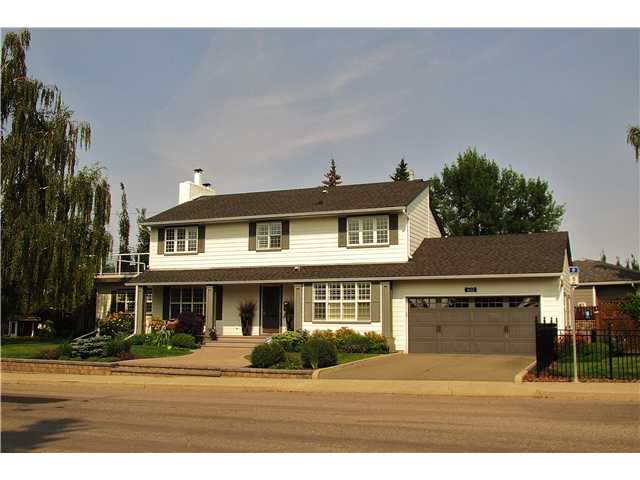
Click to view Virtual Tour
July 2013 CALGARY REGIONAL HOUSING MARKET STATISTICS
STRONG SALES GROWTH IN JULY…
Tight market conditions support upward price trend
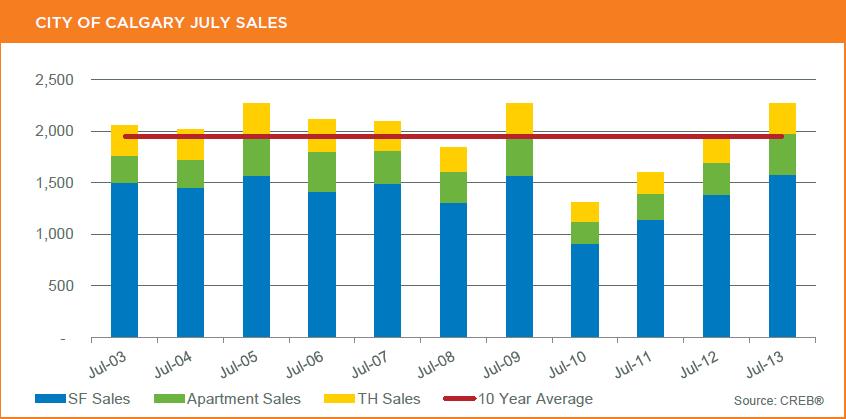
Click here or on the following link to download the full report: 2013 – July Monthly Housing Statistics
City of Calgary residential sales totaled 2,268 units in July, a 17 per cent increase over the previous year and up more than six per cent so far this year. The flood that devastated the Calgary area on June 20 likely contributed to pulling forward sales activity, said Ann-Marie Lurie, CREB® chief economist.
“Some of this activity is related to the displaced renters and owners seeking other accommodation,” said Lurie. “But those consumers already searching for a home may have sped up their purchase decision, in response to concerns regarding the impact tight supply levels would have on prices.”
The Calgary resale market is firmly in sellers’ territory, supporting price growth. While citywide prices are nearly seven per cent higher than levels recorded in July 2012, the unadjusted monthly gains have been easing. The benchmark price for the city of Calgary totalled $414,100 in July 2013.
“Some sellers have been waiting for prices to recover before listing their homes,” said President Becky Walters. “Current market conditions have encouraged listing growth this month, for single-family homeowners.” A total of 1,575 single-family homes sold in July, a 14 per cent increase over the previous year. Year-to-date, the growth is 2.5 per cent. While year-over-year new listings increased in July to 1,958 units, it was not enough to ease supply pressures in the market. Overall, active listings declined to 2,917 units, nearly 20 per cent lower than already declining levels recorded in 2012.
A total of 693 condominium apartments and townhouses sold in the month, a combined increase of 26 per cent over the previous year, and a year-to-date growth of 16 per cent. Stronger sales growth in the condominium market relative to the single-family market is in part related to availability in the affordable price ranges. Year-to-date, there have been more new listings priced under $400,000 in the condominium sector than in the single-family market.
“Clients looking for affordable homes are considering community, product and price,” Walters said. “While there are affordable single-family homes in some communities, some may prefer condominiums in the same price range so they can live in a preferred community or get a home that requires less
renovation.”
The growing demand for condominiums has also led to a tightening of supply. July active listings in the apartment and townhouse segment declined to 768 and 407 units respectively. Tight market conditions supported price growth for all categories in July. However, unadjusted monthly gains were strongest in the apartment sector. Apartment prices totaled $267,600 in July, a 1.4 per cent increase over the previous month and nearly eight per cent higher than the previous year.
The benchmark price for single-family and townhouses were a respective $461,600 and $294,500 for the month. “While the flooding will alter sales, listings and price trends in the affected areas, the impacts on the entire resale market will likely play out over the coming months,” said Lurie. “July sales growth has been stronger than year-to-date trends and long term averages.
However, if the level of new listings continues to rise, this could help ease tight market conditions.”
Click here or on the following link to download the full report: 2013 – July Monthly Housing Statistics
Calgary’s population spikes by 29,000 people in one year…
 Calgary’s population is now growing at the same pace as Houston — the oil capital of Texas and one of the fastest growing cities in the United States.
Calgary’s population is now growing at the same pace as Houston — the oil capital of Texas and one of the fastest growing cities in the United States.
While Houston has nearly double the Stampede city’s population, Calgary added nearly as many people in a two-year span — 61,370 versus 58,616.
New census data released Thursday suggests Calgary is in the midst of its second-biggest spike in two decades.
Some 29,327 new residents were recorded in a civic tally conducted between April 2012 and April 2013. The city’s population has swelled to 1,149,552 — a jump of 2.6 per cent.
Statistics from the U.S. Census Bureau indicate Calgary is adding people at a faster clip than many major American cities.
A burgeoning population is good for the city economically but brings challenges as well, cautioned Mayor Naheed Nenshi.
“We’re not quite where we were in the height of the last boom, but we’re actually not that far,” he told reporters Thursday.
“So the city continues to grow and with that comes a lot of amazing benefits, but of course a lot of real pressures.”
The fastest growing community in Calgary is Evanston — a newly built neighbourhood on the northern edge of the city — followed by Auburn Bay in the deep south and nearby Cranston.
But the numbers also suggest some meaningful shifts, with several older communities seeing small upticks in population.
A “doughnut” of neighbourhoods built between 1920 and 2000 ring the inner city and historically see stagnant growth. However, many are experiencing a welcome influx of young families to replenish the population.
An interesting case in point is Tuxedo Park, a neighbourhood in the northeast that saw a jump of 7.2 per cent over the past year.
Indeed, a third of the city’s total growth occurred in established communities, with about 10,000 people choosing to call these areas home.
It’s a departure from previous years — and an encouraging trend because it allows the city to make use of existing infrastructure rather than allocate taxpayer funds for new schools, libraries and police, Nenshi said.
“We were slowly hollowing the city out and pushing people into new neighbourhoods in the fringe. It was nothing like Detroit — nothing crazy — but that trend has largely stabilized and is beginning to reverse itself,” he noted.
People are flocking to Calgary — but the mayor insists the situation is different from the boom in 2005, when businesses had trouble retaining workers and newcomers struggled to find affordable places to live.
“We are now better equipped to handle the population,” Nenshi said. “The city might have been surprised by the mid-2000 boom …(but) I think we’re at the point where the infrastructure can handle the population we have.”
University of Calgary sociology professor Kevin McQuillan agrees.
The city’s growth rate of 2.6 per cent puts it at the high end when compared to other North American urban centres, but it doesn’t raise immediate concerns, he said.
“It puts pressure on the city, but I don’t think we’re at the stage where we would call it a real ‘boom’ that could lead to a crisis in terms of the availability of housing or services,” McQuillan said.
It remains uncertain how the June flood will affect the city’s increasingly tight vacancy rates. The tough housing market is expected to intensify when students return to school in the fall. City council is now looking at ways to accelerate the rental market to accommodate displaced apartment dwellers in areas such as Mission.
“We need to prioritize housing that matches the needs of the market,” Nenshi said. “It’s been a problem for some time.”
By Tamara Gignac, Calgary Herald July 25, 2013
Province will ban future development on floodways
In the wake of the largest flood in Alberta history, the Tory government announced a sweeping plan to move homes and businesses out of the areas most in danger from a deluge and to flood-proof other areas at risk from rising waters.
In a rare Sunday news conference, Municipal Affairs Minister Doug Griffiths announced the province will ban new development in floodways — the areas subject to the most destructive flows in so-called “100-year floods.”
The province will allow — and pay for — the repair and rebuilding of damaged homes in floodways, but it will not pay for damages from future floods on refurbished homes in those zones, he said. If a property owner chooses to relocate, the province will provide financial assistance for a new home.
Premier Alison Redford said in an interview that the government is trying to provide “the most choice with the least impact,” but acknowledged the policy will mean tough choices for some homeowners.
“There are people who have homes on the floodway that they love and we’re saying, ‘really, if you want to choose to stay there, you have to understand there are consequences.’ That’s going to be hard for people to hear, but I also think that most people are going to realize that makes sense,” she said.
In flood fringe zones — the portion of hazard areas outside of the floodway — the government will pay for repairing or rebuilding homes affected by the recent disaster, but will require flood-proofing such as berms, water control infrastructure or raising the structure.
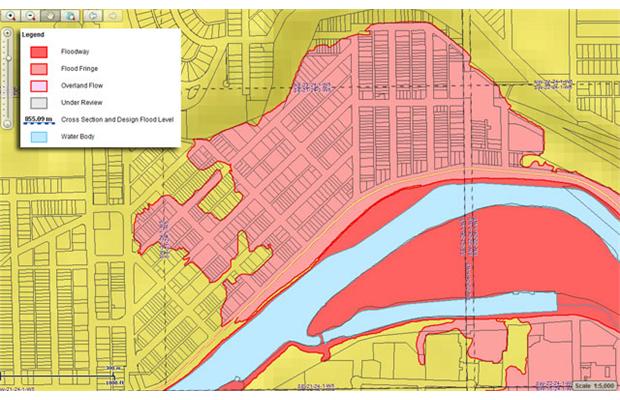
The government will pay an additional 15 per cent over replacement costs for flood-proofing measures on individual homes in some cases. In other instances, broader municipal flood mitigation efforts will suffice, but that will only be determined through consultation with municipalities, Griffiths said.
If no flood-proofing takes place, homeowners will not be eligible for disaster assistance in the case of a future inundation. Homeowners in floodways and flood fringe areas across the province who weren’t affected by the recent flooding in southern Alberta and Fort McMurray won’t be relocated and will still be eligible for assistance in case of future flooding.
Griffiths acknowledged the province has no estimate of the number of houses affected by the new policy — though he says the amount located on floodways is small — or the cost involved. The Progressive Conservative government announced an initial $1-billion for flood relief and reconstruction, but said more money would certainly be needed for a disaster estimated as causing multiple billions of dollars in damage.
Mayor Naheed Nenshi said he knows the government had to move quickly but he was surprised that such a major policy shift would take place without consultation with municipalities.
While he doesn’t disagree with the government’s intent, Nenshi is concerned about how the government will determine what properties fall within each category, saying there are differences in expert opinion over what areas should be considered floodways and what should be designated flood fringe areas.
“Our city is built at the confluence of two rivers,” he said in an interview.
“We really need to know what we’re talking about here. We ended up evacuating nearly 100,000 people, a 10th of our population, and we really need to understand what the province is talking about when we use those terms.”
Bowness, Elbow Park, Mission and Sunnyside were among the neighbourhoods hardest hit by the flooding, which began on June 20.
Nenshi noted that both the Bow and Elbow Rivers have carved slightly new courses because of the flood, requiring updates to flood mapping.
Griffiths said the province will use its existing flood hazard area maps, subject to some tweaking, to determine who falls where.
He noted that some neighbourhoods that suffered the worst flooding in High River — the town that has suffered the most from the catastrophe — have never flooded before and have not been considered part of either a floodway or flood fringe zone. What to do in cases like those has yet to be determined, he said.
Griffiths also could not say whether residents in floodways that choose to leave damaged homes will be compensated for their land, as well as the cost of their homes. He said the province will work with municipalities on a “case-by-case” basis on the issue.
“We fully understand these policies come with extensive considerations and while we don’t have all the answers to all the individual situations faced by Albertans today, we’re working as quickly as possible with municipalities to finalize the details,” said Griffiths.
Griffiths said the province will also require notification on land titles for properties in floodways and those in flood fringe areas that have not been protected against flooding.
Wildrose party Leader Danielle Smith, who represents High River as Highwood MLA, said she wanted to see the government commit to investigating the causes of the flood.
But Smith said she is in agreement with the broad outline of the government’s plan.
“What they are proposing at first blush seems to be practical,” she said.
“But what I worry about is that they’re putting almost 100 per cent of the blame and the responsibility on homeowners to solve this problem. In my opinion, there are some big, important infrastructure decisions and mitigation decisions that need to be made by the federal and provincial and municipal governments.”
With files from Don Braid, Calgary Herald







